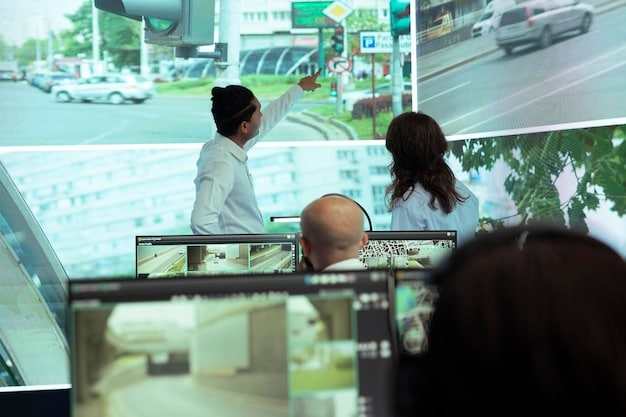Data Analytics: How Cities Use Big Data for Smarter Decisions

Data analytics empowers cities to enhance decision-making and resource allocation by transforming vast datasets into actionable insights, leading to improved urban planning, transportation management, and public safety.
Data analytics: How cities can use big data to improve decision-making and resource allocation is transforming urban centers into smarter, more efficient environments. By leveraging the power of data, cities can gain insights that drive better policies, optimize resource allocation, and enhance the quality of life for their residents.
Understanding the Role of Data Analytics in Smart Cities
Data analytics is the backbone of any smart city initiative. It involves the collection, processing, and analysis of large datasets to uncover patterns, trends, and correlations that can inform decision-making. This data-driven approach enables cities to move beyond traditional planning methods and adopt more responsive, efficient strategies.
The goal is to create a data ecosystem where information from various sources is integrated to provide a comprehensive view of the city’s operations. By understanding these dynamics, city officials can make more informed decisions about resource allocation, policy implementation, and service delivery.
Key Components of a Data Analytics Ecosystem
A robust data analytics ecosystem comprises several key components that work together to transform raw data into actionable insights.
- Data Collection: Gathering data from various sources, including sensors, IoT devices, surveys, and public records.
- Data Processing: Cleaning, transforming, and organizing data to ensure accuracy and consistency.
- Data Analysis: Applying statistical and analytical techniques to identify patterns, trends, and correlations.
- Data Visualization: Presenting data insights in a clear and accessible format, such as dashboards and reports.
These components ensure that data is not only collected but also effectively utilized to drive informed decision-making.
Ultimately, data analytics empowers cities to be more proactive and responsive to the needs of their residents, leading to improved urban living and sustainability.

Enhancing Urban Planning and Infrastructure Management
Urban planning and infrastructure management are critical areas where data analytics can have a significant impact. By analyzing data related to demographics, transportation, and land use, cities can develop more effective urban plans that promote sustainable growth and improve the quality of life for residents.
Data analytics can help cities identify areas of urban sprawl, anticipate future infrastructure needs, and optimize the use of existing resources. This data-driven approach ensures that urban development is aligned with the needs of the community and the environment.
Optimizing Transportation Systems
Transportation is a key component of urban infrastructure, and data analytics can play a crucial role in optimizing transportation systems. By analyzing traffic patterns, public transit ridership, and pedestrian activity, cities can identify bottlenecks, improve traffic flow, and enhance the efficiency of public transportation.
For example, cities can use real-time traffic data to adjust traffic signal timing, optimize bus routes, and provide commuters with up-to-date information about traffic conditions. This reduces congestion, improves air quality, and enhances the overall transportation experience.
- Real-Time Traffic Monitoring: Collecting data from sensors and cameras to monitor traffic flow and identify congestion.
- Predictive Analytics: Using historical data to forecast future traffic patterns and anticipate potential disruptions.
- Optimized Public Transit: Adjusting bus and train schedules based on ridership data to improve efficiency and reduce wait times.
These strategies enable cities to create more efficient and sustainable transportation systems that meet the needs of their residents.
By leveraging data analytics, cities can make smarter decisions about urban planning and infrastructure management, creating more livable, sustainable communities.
Improving Public Safety and Emergency Response
Public safety is a top priority for any city, and data analytics can play a crucial role in improving law enforcement efficiency and emergency response times. By analyzing crime data, incident reports, and social media activity, cities can identify crime hotspots, predict future incidents, and allocate resources more effectively.
Data-driven policing strategies can help law enforcement agencies crack down on crime, reduce response times, and improve community relations. This approach ensures that resources are deployed where they are needed most, leading to safer communities.
Predictive Policing and Crime Prevention
Predictive policing involves using data analytics to forecast when and where crimes are most likely to occur. By analyzing historical crime data, cities can identify patterns and trends that can help law enforcement agencies anticipate future incidents and deploy resources accordingly.
For example, cities can use predictive analytics to identify areas with high rates of burglary, auto theft, or violent crime. This allows law enforcement agencies to focus their efforts on these areas, increasing their chances of preventing crimes before they happen.
- Crime Mapping: Visualizing crime data on maps to identify hotspots and patterns.
- Risk Assessment: Evaluating the risk of future crimes based on historical data and current conditions.
- Resource Allocation: Deploying law enforcement resources to areas with the highest risk of crime.
Predictive policing strategies helps creating environment of safety in the cities.
With the insights from data analytics can provide rapid and effective responses in emergency situations.

Optimizing Energy Consumption and Environmental Sustainability
Energy consumption and environmental sustainability are increasingly important considerations for cities around the world. By analyzing energy usage patterns, cities can identify opportunities to reduce consumption, promote renewable energy sources, and minimize their environmental impact. Data analytics enables cities to make informed decisions about energy policies and investments.
Cities can use smart meters and sensors to collect data on energy consumption in real-time. This data can then be analyzed to identify inefficiencies, optimize energy distribution, and encourage energy conservation.
Smart Grids and Renewable Energy Integration
Smart grids are advanced energy distribution systems that use data analytics to optimize energy delivery and integrate renewable energy sources. By monitoring energy demand and supply, smart grids can automatically adjust energy flow to ensure a reliable and efficient power supply.
Smart grids can also facilitate the integration of renewable energy sources, such as solar and wind power. By forecasting energy production from renewable sources, smart grids can balance supply and demand, ensuring that renewable energy is used effectively.
These renewable energy sources enable cities with clean efficient power supply
- Real-Time Energy Monitoring: Collecting data from smart meters and sensors to monitor energy consumption in real-time.
- Demand Response Programs: Encouraging consumers to reduce energy consumption during peakDemand Response Programs: Encouraging consumers to reduce energy consumption during peak demand periods.
- Predictive Maintenance: Using data analytics to predict equipment failures and schedule maintenance proactively.
By leveraging data analytics, cities can create more sustainable energy systems that reduce their environmental impact and improve the quality of life for their residents.
Improving Healthcare Delivery and Public Health Outcomes
Healthcare delivery and public health outcomes are critical areas where data analytics can drive significant improvements. By analyzing health data, cities can identify health disparities, track disease outbreaks, and allocate resources more effectively to improve public health outcomes.
Data-driven healthcare initiatives can help cities reduce healthcare costs, improve access to care, and promote healthier lifestyles. This approach ensures that healthcare resources are targeted to the areas where they are needed most.
Precision Medicine and Personalized Healthcare
Precision medicine involves tailoring medical treatments to individual patients based on their genetic makeup, lifestyle, and environment. By analyzing large datasets of patient information, doctors can identify patterns and correlations that can inform treatment decisions.
For example, cities can use precision medicine to identify patients who are at high risk of developing certain diseases and provide them with personalized interventions. This approach can help prevent diseases, improve treatment outcomes, and reduce healthcare costs.
- Electronic Health Records: Collecting and storing patient data in electronic format to facilitate data analysis.
- Predictive Modeling: Using statistical models to predict patient outcomes and identify risk factors.
- Personalized Interventions: Tailoring medical treatments to individual patients based on their unique characteristics.
By using data analytics, the level of public health for its citizens will vastly improve.
Data analytics can do wonders to the efficiency of medical treatments.
Engaging Citizens and Promoting Transparency
Engaging citizens and promoting transparency are essential for building trust between cities and their residents. By using data analytics to provide citizens with access to information about city services, policies, and performance, cities can empower residents to participate more actively in local government.
Transparent data practices enable citizens to hold their elected officials accountable and make informed decisions about local issues. This approach fosters a sense of community and strengthens the bond between residents and their government.
Open Data Initiatives and Citizen Feedback
Open data initiatives involve making city data freely available to the public. This allows citizens, researchers, and entrepreneurs to access and analyze data about city services, policies, and performance.
For example, cities can publish data about crime rates, traffic conditions, and energy consumption on their websites. This data can then be used by citizens to create apps, conduct research, and advocate for policy changes.
- Data Portals: Providing a central location for citizens to access city data.
- Citizen Surveys: Collecting feedback from residents about their satisfaction with city services.
- Community Forums: Hosting public meetings to discuss local issues and gather citizen input.
The level of transparency will impact the level of trust in the government.
Ultimately, data analytics empowers citizens to participate more actively in local government, fostering a stronger sense of community and accountability.
| Key Point | Brief Description |
|---|---|
| 📊 Data Collection | Gathering data from sensors, IoT, and public records. |
| 🚦 Transportation Optimization | Using data to improve traffic flow and public transit. |
| 🚨 Public Safety | Employing data analytics for predictive policing. |
| ⚡ Energy Efficiency | Optimizing energy use and integrating renewable sources. |
Frequently Asked Questions
Data analytics in smart cities involves collecting and analyzing large datasets to improve decision-making and optimize resource allocation. This leads to better urban planning, efficient transportation, and enhanced public safety.
By analyzing demographic, transportation, and land-use data, cities can develop sustainable urban plans. This includes identifying urban sprawl areas, anticipating infrastructure needs, and optimizing resource use.
Data analytics enhances public safety by identifying crime hotspots, predicting incidents, and allocating resources effectively. Predictive policing strategies help law enforcement agencies prevent crimes and improve community relations.
Cities can reduce energy consumption by analyzing energy usage patterns and promoting renewable energy sources. Smart grids and real-time energy monitoring optimize energy distribution, encouraging conservation.
Engaging citizens builds trust by providing transparent access to city data and policies. Open data initiatives and citizen feedback mechanisms empower residents to participate actively in local government.
Conclusion
In conclusion, data analytics: How cities can use big data to improve decision-making and resource allocation offers a powerful pathway to transform urban centers. By fully embracing the power of data, cities can enhance the lives of their citizens, building more sustainable, resilient, and thriving communities.





